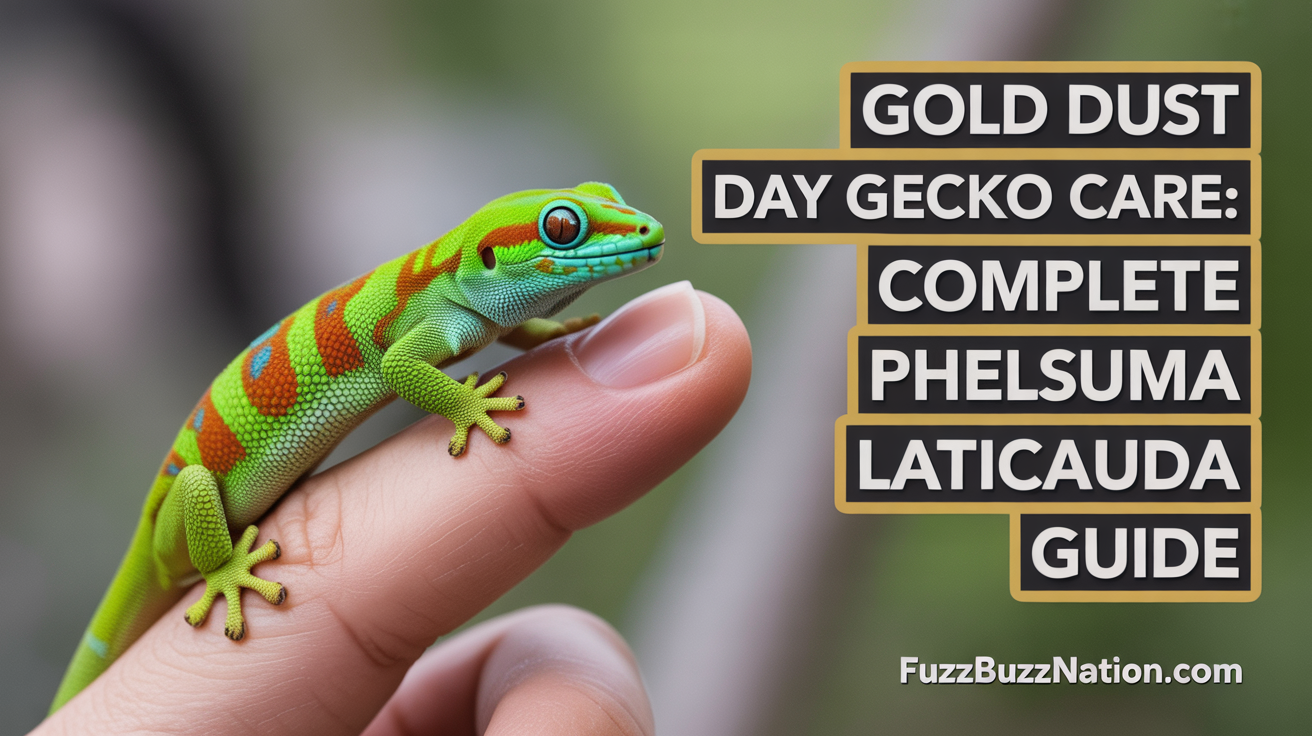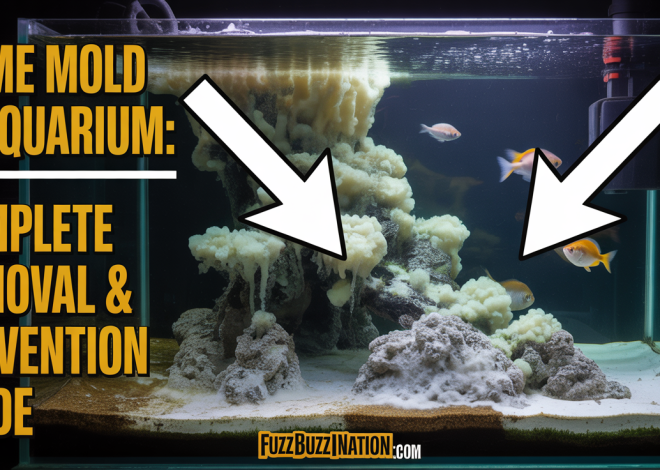
Gold Dust Day Gecko Care: Complete Phelsuma laticauda Guide
Gold dust day geckos (Phelsuma laticauda) require specialized care including high humidity levels of 70-80%, daytime temperatures of 78-85°F with basking spots reaching 90°F, and UVB lighting to support their active, arboreal lifestyle and calcium metabolism. After successfully maintaining and breeding gold dust day geckos for over ten years, including raising multiple generations from my founding breeding group, I’ve learned that these beautiful Madagascar natives demand precise environmental conditions and gentle handling techniques that respect their delicate skin and stress-sensitive nature.
The key to successful gold dust day gecko keeping lies in understanding their natural rainforest habitat requirements, providing adequate vertical space for climbing, and maintaining consistent environmental parameters while avoiding the common mistake of treating them like hardier gecko species that tolerate handling and environmental fluctuations.
Understanding Gold Dust Day Gecko Natural History
Gold dust day geckos originate from Madagascar and surrounding islands, inhabiting tropical rainforests where they live arboreally among bamboo, palms, and flowering trees. Their natural environment features high humidity, warm temperatures, and abundant insect prey along with nectar sources from various flowering plants.
These geckos reach 4-6 inches in total length, with vibrant green coloration accented by distinctive gold spots that give them their common name. The intensity of their colors varies with temperature, mood, and health status, providing visual cues about their well-being.
In my breeding experience, I’ve observed that gold dust day geckos maintain territories around food sources and preferred basking locations, displaying complex social behaviors including head bobbing, tail waving, and vocalizations during territorial disputes or courtship.
Their natural diet consists primarily of small insects, spiders, and nectar from flowers, making them omnivorous feeders with specific nutritional requirements that must be replicated in captivity for optimal health and breeding success.
Wild populations face pressure from habitat destruction and collection, making captive breeding efforts important for maintaining genetic diversity while reducing demand for wild-caught specimens that often struggle with captive adaptation.
Essential Housing Requirements
Adult gold dust day geckos require minimum enclosure dimensions of 18″x18″x24″ tall for a single animal, though larger enclosures of 24″x18″x36″ or bigger produce better results with more natural behaviors and reduced stress indicators.
Vertical orientation remains crucial due to their arboreal nature, with height being more important than floor space. I use custom-built enclosures that prioritize vertical climbing opportunities over horizontal space allocation.
Ventilation design must balance humidity retention with air circulation to prevent stagnant conditions that promote bacterial and fungal growth. I achieve this using partial screen tops with solid sides that maintain humidity while ensuring adequate airflow.
Live plants serve multiple functions including humidity regulation, hiding spots, and climbing surfaces that replicate natural habitat conditions. I’ve had success with pothos, ficus benjamina, snake plants, and bromeliads that tolerate high humidity conditions.
Substrate selection affects both hygiene and humidity maintenance. I prefer coconut fiber mixed with sphagnum moss that retains moisture while allowing easy cleaning and replacement when necessary.
Multiple hiding spots at various levels accommodate their territorial nature and provide security during rest periods. Cork bark tubes, live plant foliage, and artificial caves create appropriate retreat options.
Temperature and Heating Management
Daytime temperatures should range from 78-85°F with basking spots reaching 90-95°F, achieved through ceramic heat emitters, halogen bulbs, or other overhead heating sources that create natural thermal gradients.
I maintain nighttime temperature drops to 70-75°F that simulate natural cooling cycles and support healthy circadian rhythms essential for breeding behavior and overall well-being.
Temperature gradients allow thermoregulation through behavioral choices, with cooler areas near 78°F and progressively warmer zones approaching basking temperatures of 90-95°F.
Heating placement must avoid creating hot spots that could cause thermal burns while ensuring adequate warmth distribution throughout the vertical enclosure space.
Thermostats control heating equipment to prevent dangerous temperature spikes that can be fatal to these sensitive geckos. I use multiple thermometers placed at different enclosure levels to monitor temperature variations.
Seasonal temperature cycling may encourage breeding behavior, though consistent temperatures work well for pet animals not intended for reproduction.
Lighting Requirements and UVB Needs
UVB lighting proves essential for gold dust day geckos despite their primarily diurnal nature, supporting calcium metabolism and preventing metabolic bone disease that can develop without adequate UV exposure.
I use T5 HO fluorescent tubes providing 5-10% UVB output, positioned 6-12 inches from basking surfaces without glass or plastic barriers that filter beneficial wavelengths.
Photoperiod regulation follows their natural habitat patterns with 12-14 hour days during active seasons and 10-12 hours during cooler months to support natural biological rhythms.
Full-spectrum lighting enhances coloration and natural behaviors while supporting plant growth in bioactive enclosures that benefit from live vegetation and beneficial microorganisms.
LED supplementation can provide additional illumination for viewing and plant growth while UVB tubes handle the specific wavelength requirements for gecko health and calcium absorption.
Light replacement schedules are crucial, as UVB output diminishes significantly before bulbs stop producing visible light. I replace UVB bulbs every 8-10 months regardless of apparent function.
Humidity Control and Water Management
Humidity levels between 70-80% are essential for gold dust day gecko health, supporting proper shedding, respiratory function, and overall comfort in their tropical environment requirements.
I maintain humidity through daily misting, automated misting systems, and moisture-retaining substrates that create stable humidity levels without creating overly wet conditions.
Water provision includes both misting for drinking and humidity maintenance, as these geckos rarely use standing water dishes but readily drink from water droplets on surfaces.
Drainage systems prevent water accumulation that could lead to bacterial growth or substrate spoilage. I use false bottoms or drainage layers in planted enclosures to manage excess moisture.
Humidity monitoring through digital hygrometers placed at multiple enclosure levels ensures appropriate moisture levels while identifying areas that might be too dry or excessively wet.
Ventilation balance prevents stagnant air while maintaining necessary humidity levels. Too much airflow drops humidity quickly, while insufficient ventilation promotes harmful bacterial growth.
Diet and Feeding Requirements
Commercial gecko diets designed for day geckos provide nutritional foundations, though I supplement these with live insects and fresh fruit purees for optimal nutrition and behavioral enrichment.
Cricket feeding includes appropriately sized insects, typically 1/4 to 3/8 inch crickets for adult geckos, gut-loaded 24-48 hours before feeding with high-quality commercial gut load or fresh vegetables.
Through my breeding program, I’ve observed that varied diets produce better breeding results and more vibrant coloration than single-food sources, making dietary diversity important for optimal health.
Fruit feeding includes small amounts of pureed baby food fruits like mango, papaya, or banana offered 2-3 times weekly as supplements to their primary insect diet.
Feeding frequency varies by age, with juveniles requiring daily feeding while adults do well with feeding every other day or 2-3 times weekly depending on body condition.
Calcium supplementation through dusting insects with calcium powder ensures adequate mineral intake for bone health and egg production in breeding females.
Handling Considerations and Stress Management
Gold dust day geckos have extremely delicate skin that tears easily when handled, making them observation animals rather than pets for regular interaction or handling.
I avoid handling except for necessary health checks or enclosure maintenance, as their skin can be permanently damaged by improper contact that removes protective scales or causes injury.
Stress indicators include color fading, hiding behavior, reduced appetite, and excessive activity that suggest environmental problems or handling stress affecting their well-being.
Capture techniques for necessary handling involve herding geckos into containers rather than grasping them directly, preventing skin damage while allowing safe transport for veterinary care.
Enrichment through environmental complexity, feeding variety, and appropriate social grouping reduces stress while providing mental stimulation that supports natural behaviors.
Territory establishment through adequate space and visual barriers reduces aggressive interactions when housing multiple geckos in larger enclosures.
Health Monitoring and Common Issues
Shedding problems often result from inadequate humidity and manifest as retained shed on toes, tail tips, or around the eyes that can cause circulation problems if not addressed promptly.
I monitor shedding cycles carefully and increase humidity temporarily when geckos show signs of beginning shed cycles, ensuring complete, healthy skin removal.
Metabolic bone disease can develop without proper UVB lighting and calcium supplementation, showing as soft jaw bones, kinked tails, or difficulty climbing that requires immediate veterinary attention.
Respiratory infections may occur with poor ventilation or temperature fluctuations, manifesting as mouth breathing, wheezing, or lethargy that needs professional treatment.
Parasite problems including mites or internal parasites can affect captive geckos, requiring fecal examinations and appropriate treatment protocols under veterinary guidance.
Weight monitoring through regular observation helps identify health changes before they become serious, as weight loss often indicates developing problems.
Breeding Considerations and Reproduction
Sexual maturity occurs around 12-18 months of age in well-cared-for gold dust day geckos, with females typically maturing slightly later than males.
Male identification includes prominent femoral pores, bulkier build, and more territorial behaviors during breeding season, while females remain smaller with less prominent features.
I’ve found that breeding pairs require substantial space and multiple egg-laying sites, as females may lay eggs every 3-4 weeks during breeding season with proper environmental conditions.
Egg incubation occurs at 78-82°F with high humidity in vermiculite or perlite substrates, with incubation periods lasting 55-65 days depending on temperature consistency.
Hatchling care requires smaller prey items, higher humidity, and more frequent feeding schedules in appropriately scaled enclosures that accommodate their tiny size.
Breeding success improves with seasonal cycling, proper nutrition, and stress-free environments that encourage natural reproductive behaviors.
Species-Specific Behavior and Social Dynamics
Gold dust day geckos display complex territorial behaviors including scent marking, visual displays, and vocalizations that communicate social status and breeding readiness.
Activity patterns peak during morning and late afternoon hours when they actively hunt, bask, and engage in social interactions before becoming less active during midday heat.
Territorial requirements mean that multiple animals need substantial space with visual barriers and multiple resource locations to prevent constant stress from competitive interactions.
Communication includes tail waving, head bobbing, and clicking vocalizations that serve various social functions from territorial claims to courtship displays.
Natural behaviors like nectar feeding can be encouraged through appropriate flowering plants in bioactive enclosures that provide environmental enrichment and behavioral opportunities.
Common Mistakes and Problem Prevention
Inappropriate handling represents the most serious mistake, as gold dust day gecko skin damage from improper contact can result in permanent scarring, infection, or death from stress.
Inadequate humidity levels cause shedding problems, respiratory stress, and overall health decline that can be prevented through proper environmental monitoring and maintenance.
I’ve seen many cases where new keepers underestimate the precise environmental requirements these geckos need, leading to health problems that proper setup would prevent.
Insufficient UVB lighting results in metabolic bone disease that becomes apparent through deformed growth, weak bones, and mobility problems requiring extensive veterinary intervention.
Poor ventilation while maintaining humidity creates conditions favoring bacterial and fungal growth that can cause serious respiratory and skin infections.
Advanced Husbandry Techniques
Bioactive enclosures using live plants, beneficial bacteria, and cleanup crews create self-sustaining ecosystems that maintain humidity while processing waste naturally.
Automated misting systems provide consistent humidity and drinking opportunities while reducing daily maintenance requirements for busy keepers.
I use seasonal lighting and temperature cycling that mimics natural patterns to encourage breeding behavior and maintain healthy circadian rhythms.
Quarantine protocols for new animals prevent disease introduction to established colonies while allowing health assessment and stress reduction before introduction.
Environmental Enrichment and Behavioral Needs
Climbing opportunities through varied branch diameters, cork bark, and live plants encourage natural locomotion and provide exercise that maintains physical fitness.
Feeding enrichment includes hiding insects in bark crevices or among plants to stimulate natural hunting behaviors that provide mental stimulation and physical activity.
Visual barriers through dense planting and strategic decorations reduce stress by allowing geckos to retreat from view while maintaining territory establishment.
Temperature gradients throughout the enclosure height allow behavioral thermoregulation that supports natural activity patterns and physiological functions.
Frequently Asked Questions
How often should I handle my gold dust day gecko?
Gold dust day geckos should rarely be handled due to their extremely delicate skin that can be permanently damaged by human contact. Limit handling to essential health checks or veterinary visits only, using gentle herding techniques to guide them into containers rather than direct contact. These geckos are best appreciated as observation animals rather than interactive pets. Their beautiful colors and interesting behaviors provide plenty of enjoyment without the risks associated with regular handling.
What temperature should I keep my gold dust day gecko’s enclosure?
Maintain daytime temperatures of 78-85°F with basking spots reaching 90-95°F, achieved through overhead heating sources. Nighttime temperatures should drop to 70-75°F to simulate natural cooling cycles. Use multiple thermometers at different enclosure levels to monitor temperature gradients, and always use thermostats to prevent dangerous overheating. Consistent temperatures are more important than exact numbers, but staying within these ranges supports proper digestion, activity, and overall health.
Can I keep multiple gold dust day geckos together?
Yes, but it requires careful planning and adequate space. A breeding pair can coexist in enclosures of 24″x18″x36″ or larger with multiple hiding spots and visual barriers. Multiple males should never be housed together due to territorial aggression. Monitor for stress signs including color fading, reduced appetite, or excessive hiding that might indicate incompatibility. Larger enclosures with complex environments work better for group housing than minimal setups.
What plants are safe for gold dust day gecko enclosures?
Safe live plants include pothos, ficus benjamina, snake plants, bromeliads, and many orchids that tolerate high humidity conditions. Avoid plants treated with pesticides or fertilizers, and research any plant thoroughly before introduction. Live plants provide humidity regulation, climbing surfaces, and hiding spots while creating more natural environments. Artificial plants can work but don’t provide the same environmental benefits as living vegetation.
How do I know if my gold dust day gecko is sick?
Watch for changes in appetite, activity level, coloration, or behavior patterns that might indicate health problems. Signs of illness include persistent color fading, difficulty shedding, breathing problems, weight loss, or unusual lethargy. Retained shed on toes or tail tips requires immediate attention to prevent circulation problems. Any concerning changes warrant consultation with a reptile veterinarian, as early intervention often prevents minor issues from becoming serious health problems.
Long-Term Success with Gold Dust Day Geckos
Successful gold dust day gecko keeping requires commitment to maintaining precise environmental conditions, understanding their specific behavioral needs, and resisting the urge to handle these delicate animals unnecessarily.
Focus on creating stable, appropriate environments rather than perfect ones, as consistency in temperature, humidity, and lighting proves more important than achieving exact specifications for every parameter.
Build relationships with experienced reptile veterinarians and gecko keeping communities that can provide support and guidance throughout your gecko’s 10-15 year lifespan potential.
Remember that these geckos reward proper care with vibrant colors, interesting behaviors, and potentially successful breeding that contributes to captive population sustainability.
The investment in quality setup and maintenance pays dividends through years of enjoyment watching these remarkable geckos display their natural behaviors in appropriate captive environments that support their health and well-being.


